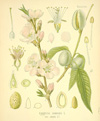
Preservatives in Natural Cosmetics...... and How to Use Them. I often receive emails on how to preserve natural cosmetics and skin care ingredients. The main concerns are bacteria and fungus, followed by oxidation. If a product is intended to be used within a month, a preservative isn’t required unless it contains fresh fruit or vegetables (as this will only keep for 3-7 days), however, it should be stored in the refrigerator. If your formula contains a high quantity of oil, an antioxidant is required to prevent it becoming rancid– usually 1% in the form of pure vitamin E (Tocopherol-d-alpha) which is normally derived from soybeans. There is also synthetic vitamin E available (Vitamin E Acetate). You can also use vitamin A (retinol) and C (ascorbic acid). Balms generally don’t need to have more than an antioxidant as there is no water in the formulation. However, if it is in a pot that will have fingers dipped in regularly, it is recommended to add an essential oil that has antibacterial properties… eg benzoin, thyme or tea tree depending on the purpose of the balm. If it's a lip balm, benzoin tastes nicer as it's similar to vanilla. Gels, Ointments and Lotions must have preservatives (antimicrobials, fungicides and antioxidants) if your formula is going to last more than a month, as moisture (in this case water) will provide the perfect environment for bacteria and fungus to grow. Cleaning and sterilising your equipment, containers and work area helps minimise contamination, as does wearing gloves and a face mask. I use ethanol to wipe down all my tools and work area prior to manufacturing – methylated spirits will work as well. Some antimicrobials are also fungicides – eg alcohol/ethanol. If you cannot obtain pure ethanol, 70% proof vodka and higher can be substituted. Ethanol is used at 15-20% in your formulation, vodka will need to be used at a higher level depending on its strength. If you are using herbal tinctures (alcohol based), they will help reduce the % of alcohol-based preservative required. As alcohol can be drying in a formula when it is applied to the skin, vegetable glycerine is added to the formulation to prevent this. Essential oils have a mild antimicrobial effect, and this can also be taken into account when creating the formula. Generally, they are not enough to use alone (unless the product will be used within 6 weeks), so another form of preservative is required for optimum longevity. Benzoin Tincture is a popular preservative and benzoin has been used for centuries as such. One option recommended by the author of Bodycraft, Nerys Purchon (Stubbin, 1999) is to use 4% benzoin tincture combined with 10% glycerine as a total preservative and in my experience, this works well in many formulations (blend together before applying to your product or you will get large flakes of benzoin resin floating in it). This can be added to the water phase or stirred in at the end depending on your emulsification process. I have tried Myrrh and Frankincense Tinctures, but again, these have not been as successful as Benzoin Tincture. Citrus Seed Extract is a natural preservative that is available, however, from experience, it only has a 2-year shelf life and it is recommended to find out the expiry date before you purchase it. 1% is the recommended requirement for creams and lotions and is added to the water phase. Potassium Sorbate in my experience is best kept for shampoos and shower gels… I don’t know why, but it doesn’t seem to be as effective in lotions and ointments and product wastage is high. Again it may be due to shelf life, however, I have never received any with a date on it… and increasing the percentage doesn’t seem to make any difference. Geogard® 221 is based on dehydroacetic acid (DHA) [7.7-8.3%] and benzyl alcohol [85-89%] and Water [4%], and therefore is recognized by major cosmetic, toiletry and fragrance regulatory authorities worldwide for use in cosmetic and personal care products. Geogard®221 is light in colour, essentially odourless and compatible in a diverse range of product formulations. It can be used in creams, lotions, shampoos and gels. Use between pH 2–7 as efficacy can be compromised above a pH of 7. Can be added at both room and elevated temperatures. Enhanced compatibility allows for the addition of Geogard®221 virtually anywhere in the manufacturing process. Anionics may cause discolouration in carbomers and certain surfactants. Highly soluble in polar organic solvents.
I hope this is of some help to you. Tania J Tania Cottew DipAroma References: |



